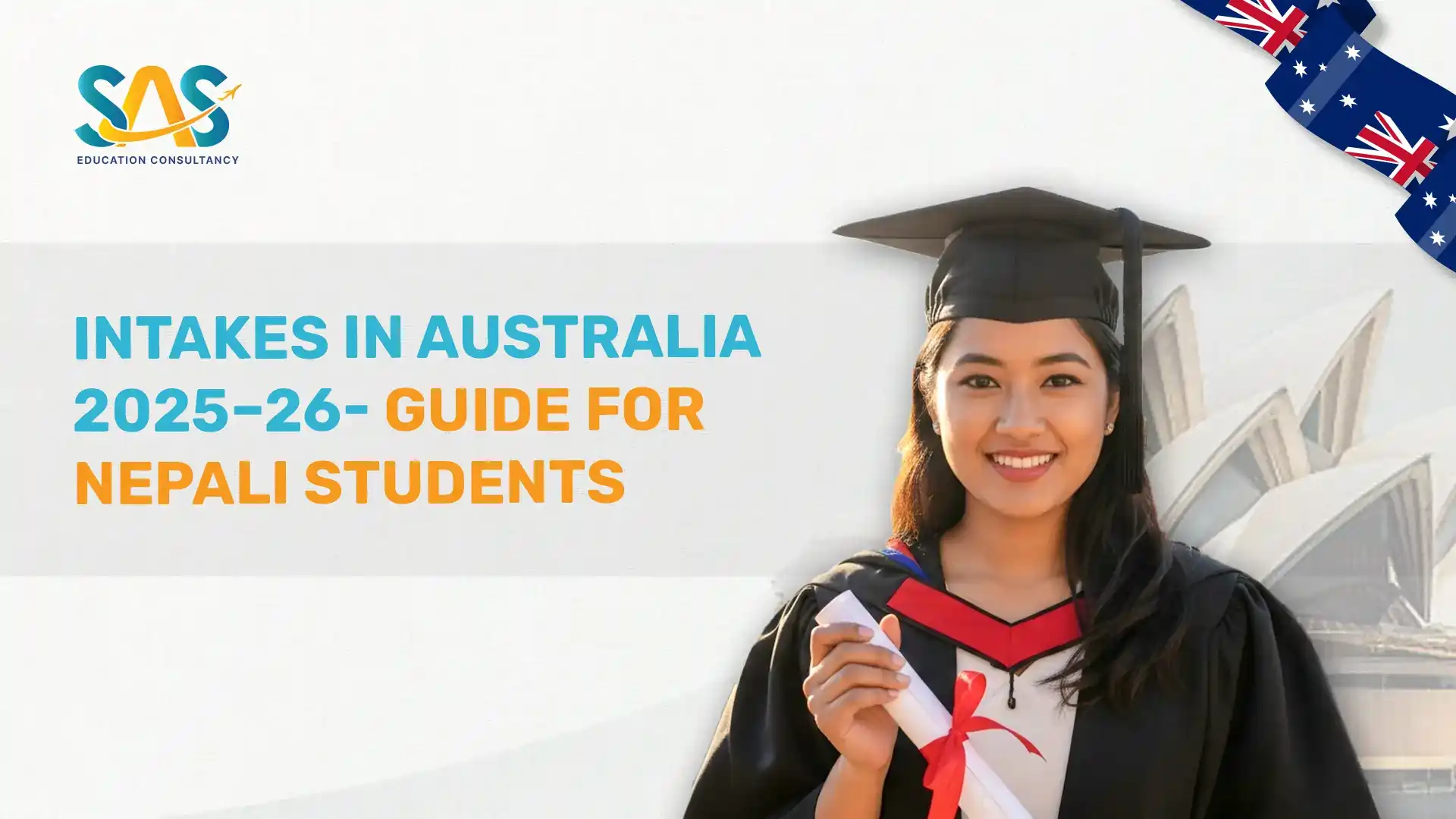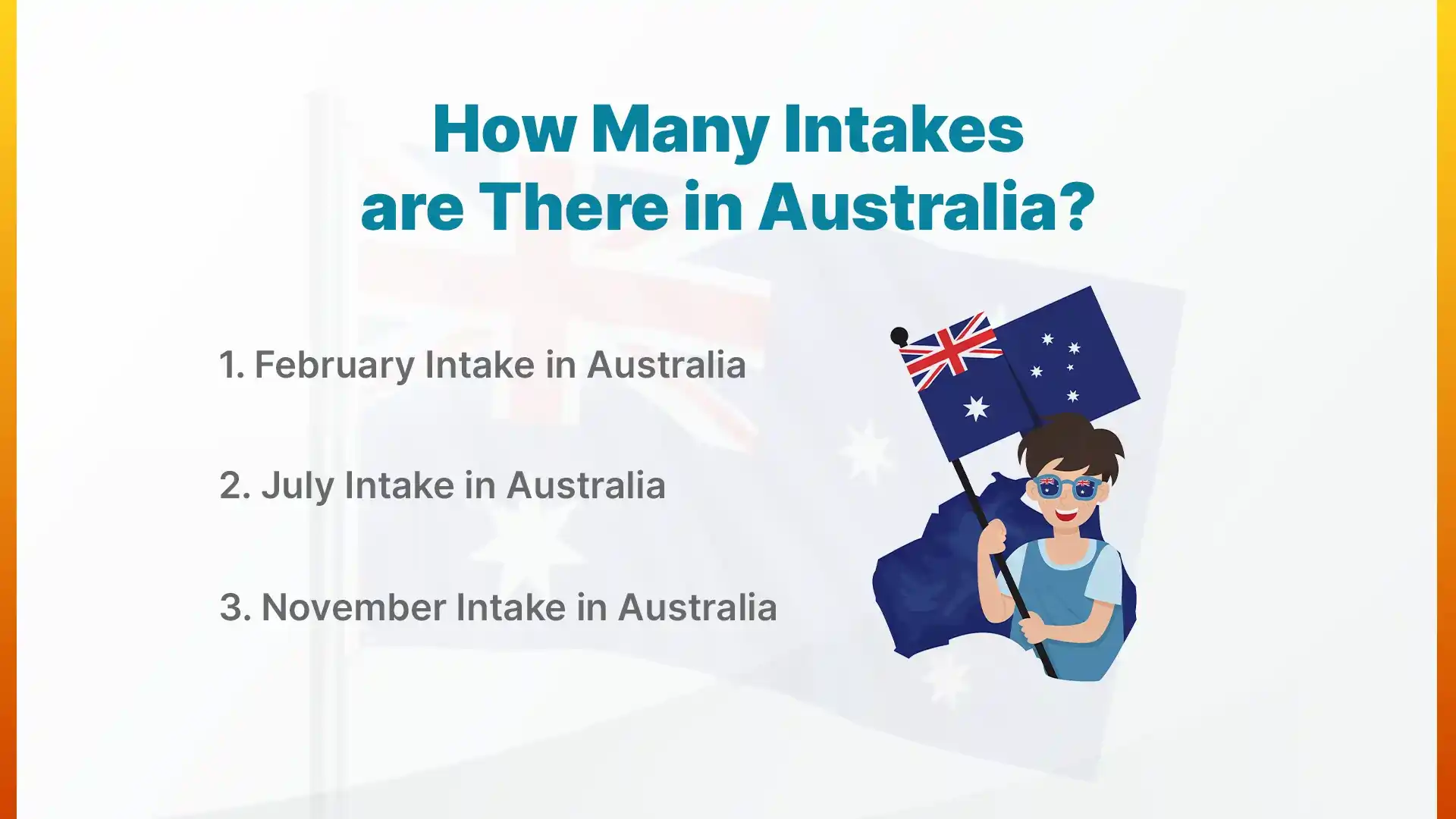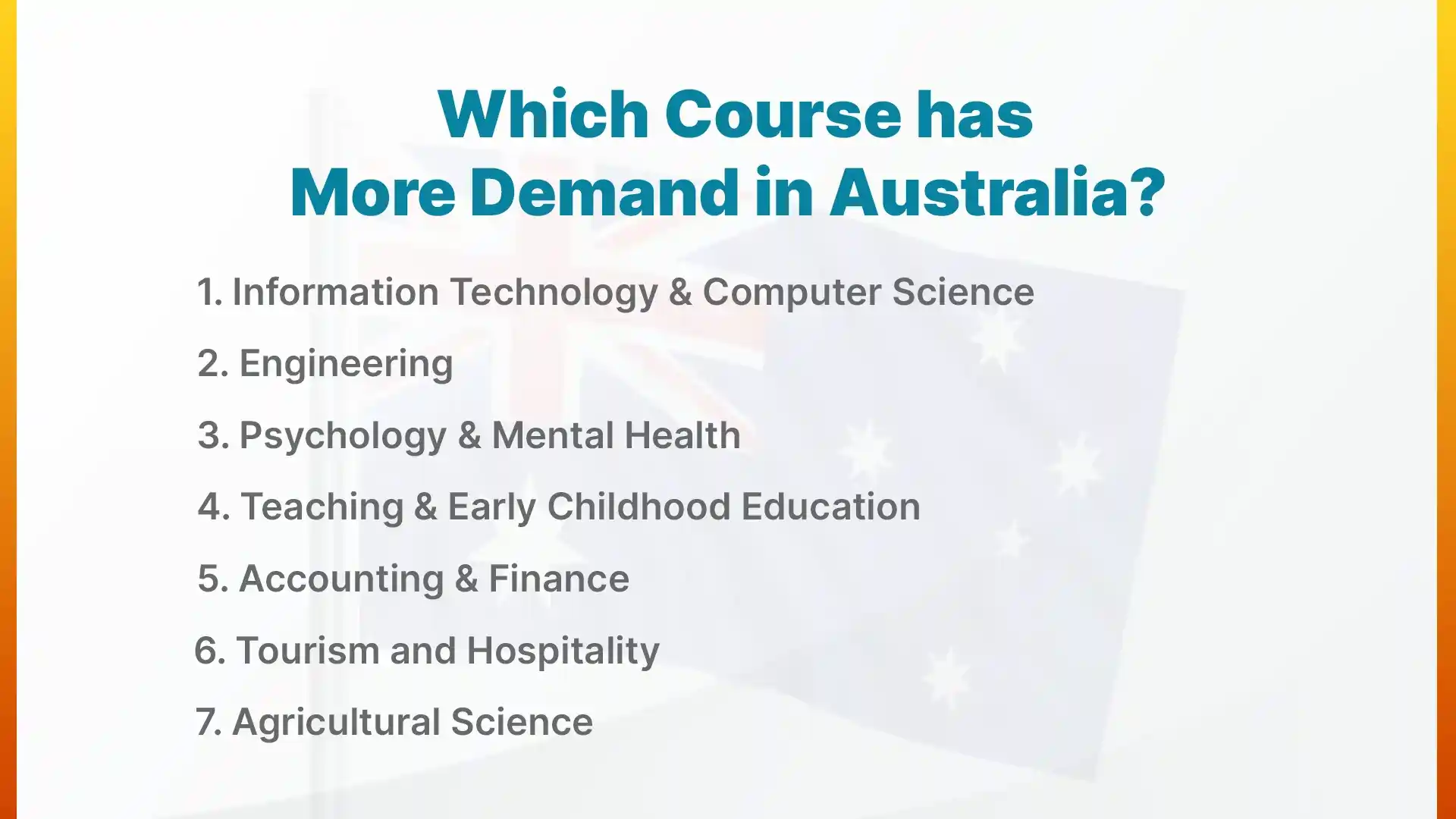Intakes in Australia 2025–26: February, July & November

Studying in Australia is a pathway to global exposure, personal growth, and long-term career success. For Nepalese students, Australia has become one of the top destinations in 2025, thanks to its world-class universities, cultural diversity, and strong job opportunities after graduation.
But before you think about visas or scholarships, one of the first and most important decisions you’ll need to make is choosing the right intake in Australia. The intake you apply for directly impacts your course availability, scholarship chances, and even your visa preparation timeline.
In this guide, we’ll break down all the intakes in Australia in detail and help you figure out which one is the best fit for your academic and personal goals.
What are the Intakes in Australia?
Australian universities have three major intakes: February, July, and November every year. These are the periods when universities and colleges in Australia open admission and accept new students worldwide.
Unlike Nepal, where most courses begin once a year, Australian universities offer multiple intakes, giving students more flexibility to start their studies when they’re ready.
Why does this matter? Because intakes affect your choice of course, scholarship, and entire visa planning. Choosing the right intake ensures you have enough time and opportunities to study in Australia from Nepal.
Below, we have discussed all three Australian intakes in detail:

1. February Intake in Australia
The February intake is the biggest and most popular intake in Australia. It usually starts from late January to early February and offers the widest range of programs across all major universities.
Why is February Intake the Most Popular in Australia?
February intake is the major intake in Australia since most universities traditionally begin their academic year this month. This intake opens admission for a majority of courses and Australian scholarship opportunities, higher than those in other intakes. The February intake also merges you with other competitive students who were not only serious about the preparation but also made it through the competition. This gives you a vibrant campus life, with lots of festivals, clubs, and networking opportunities at their peak.
Pros & Cons of February Intake
Pros | Cons |
| Largest number of courses available | Higher competition for seats and scholarships |
| More scholarship opportunities | Application deadlines come earlier (need early preparation) |
| Vibrant student life with orientation programs | Limited time for those deciding late |
| Easier to sync with job markets and internships | Higher demand for accommodation |
Who Should Consider Australia’s February Intake?
- Students aiming for maximum program choices and scholarships.
- Those who are well-prepared with test scores (IELTS, TOEFL, PTE) and documents.
- Anyone looking for a full campus experience with plenty of networking and career opportunities.
When Can You Apply for the February Intake in Australia?
You must apply between August and November for the February intake in Australia. This is the primary application period for many universities. Applying as early as possible so you get a better chance for admission and more time for visa processing.
2. July Intake in Australia
The July intake (also called the Winter intake) is the second most popular intake in Australia. It usually begins in late June or early July and offers plenty of opportunities for students who missed the February intake.
Pros & Cons of July Intake
Pros | Cons |
| A decent range of programs is still offered | Slightly fewer courses compared to February |
| Less competition for admission and visas | Fewer scholarship opportunities |
| More time to prepare after finishing +2/undergrad in Nepal | Campus activities may feel quieter |
| Good timing for part-time job openings in mid-year | Internships may not align as smoothly with the course start |
Who Should Consider Australia’s July Intake?
- Students who missed February deadlines but don’t want to wait a whole year.
- Those who need extra time to prepare documents, finances, or test scores.
- Students applying for programs that are available year-round (like Business, IT, or some Engineering streams).
When to Apply for the July Intake in Australia?
For a July intake in Australia, you should plan to apply between February and March or April of the same year. If you’re planning to reach Australia for the upcoming July 2026 intake, you should fill out the application forms within February and March og 2026. The exact deadlines might vary, so make sure to check the official website of your chosen university.
3. October/November Intake in Australia
The October/November intake (also called the Spring intake) is the least common of the three. It usually starts from October to early November and is often limited to specific universities or short-term/vocational programs, certificate courses, diplomas, and postgraduate programs. Even with fewer options, it is a good option for students looking for flexible pathways into degree programs.
Pros & Cons of November Intake in Australia
Pros | Cons |
| Offers a third chance if you missed February and July | Very limited course availability |
| Smaller intake means less competition | Fewer scholarships compared to other intakes |
| Quicker entry into short courses and diplomas | Fewer universities participate |
| Flexible option for students with last-minute plans | The campus may feel less lively |
Who Should Consider the October/November Intake in Australia?
- Students planning to take short courses, diplomas, or vocational programs.
- Those looking for a quick entry point and willing to transition into degree programs later.
- Anyone with last-minute decisions who doesn’t want to wait for the next February or July intake.
When to Apply for the November Intake in Australia?
Applications usually open around February–March of the same year, with deadlines falling by August–September. Since options are limited, applying early is crucial to avoid missing out.
February vs July vs November Intake in Australia
Among all three intakes, February is the most popular in Australia. It has the widest range of courses, the highest number of scholarships, and the liveliest campus life. July comes second, offering a good balance for those who miss February. November is the smallest intake, with limited course options, mainly suited for short-term or vocational studies.
Comparison Table of Intakes in Australia
February Intake | July Intake | November Intake |
| Starts around Late Jan – Early Feb | Starts around Late June – Early July | Starts around Oct – Early Nov |
| Almost all programs are open, with the widest choice | Many programs open, but slightly fewer | Limited programs, mostly diplomas or specific courses |
| Highest funding and top scholarship chances | Moderate scholarship and funding chances | Lowest scholarship opportunities |
| High competition since most applicants target this intake | Moderate competition, still with a lot of students applying | Low competition with fewer students, but fewer programs too |
| Most vibrant campus life, with festivals & orientation | Active extra-curriculum but slightly quieter | Limited extra activities |
| Application deadlines range from Aug to Nov of the previous year | Application deadlines from February to March of the previous year | Apply by Aug–Sept of the same year |
Which Intake is Best for Australia from Nepal?
For Nepali students, the February intake is usually the best choice. It offers the widest selection of courses, the most scholarships, and better chances to engage in campus life and part-time job opportunities.
However, not everyone can prepare in time for February. If you need extra months to get your IELTS scores, arrange finances, or collect documents, then the July intake is a strong alternative. It still offers good program options and less competition.
The November intake, though limited, can work for students aiming for diplomas, short-term programs, or those who missed both earlier intakes.
The best intake depends on your readiness, career plan, and personal strategy:
- Choose the February intake if you want maximum and prestigious opportunities.
- Choose the July intake if you need extra preparation time with some compromise in top admissions, but there’s no loss until you have very specific preferences.
- Choose November if you prefer diplomas or last-minute entry to avoid a year gap.
How to Choose the Best Intake in Australia?
If you’re aiming for maximum scholarship opportunities and campus life, the February intake is often ideal. However, students with pending test results, financial planning, or visa timelines may find July more suitable. Some programs are only offered in February, while others may also be available in July or November.
The key is to match your academic and personal preparedness with the intake that offers the most benefits. Ultimately, the best intake in Australia for you depends on your course availability, readiness, and personal timeline. Here’s how you can make an informed choice:
1. Check Course Availability
Not all programs are offered in every intake. For example, high-demand fields like Medicine, Nursing, or certain Engineering courses may only start in February. Start by shortlisting your courses and cross-check which intakes they’re available in. This step saves time and ensures you’re targeting realistic options.
2. Compare Scholarship Opportunities
Scholarships can make a huge difference, especially for Nepali students studying abroad. February is often the most generous in terms of funding, while July has moderate options, and November is limited. Understand the total cost of studying in Australia and keep your financial goals in mind when choosing your intake.
3. Consider Visa Processing Times and Deadlines
Visa approval isn’t instant. Factor in time for documentation, interviews, and potential delays. An intake that aligns with your preparedness can prevent unnecessary stress and rushed applications.
4. Align Intake with Career and Academic Goals
Think ahead. When do internships or job placements typically begin in Australia? February intake often syncs best with Australia’s internship and recruitment cycles, giving you an edge in real-world experience during your studies and right after your graduation as well. Think of your present plans as well.
5. Evaluate Personal Readiness
Be honest with yourself. Are you confidently ready with your finances, English test scores (IELTS, PTE, TOEFL), and supporting documents? If you’re not fully prepared, it might be smarter to aim for July or November rather than rush into February unprepared.
Choosing an intake isn’t just about availability; it’s about what fits your life, preparation, and goals. The right timing can set the tone for your entire study experience.
Which Course Has More Demand in Australia?
Information Technology, Engineering, and Health-related programs are among the most in-demand courses in Australia. These fields are tied to skill shortages in the country, meaning graduates often enjoy better job prospects and migration opportunities. Other areas such as Accounting, Education, and Agriculture. Choosing a course that aligns with both your interests and Australia’s job market can maximize your career opportunities.
Here’s a closer look at the most in-demand courses:

1. Information Technology & Computer Science
The tech sector in Australia is booming. Graduates in AI, software development, cybersecurity, and data science are highly sought after. If you enjoy problem-solving and innovation, IT or Computer Science is a smart choice.
2. Engineering
From civil and mechanical to electrical and mining engineering, this field is stable and in demand. Australia’s infrastructure projects and industrial growth continue to fuel opportunities for qualified engineers.
3. Psychology & Mental Health
The demand for mental health professionals is rising across schools, hospitals, and community services. Courses in Psychology, Counselling, and Social Work are increasingly relevant for today’s needs.
4. Teaching & Early Childhood Education
Qualified teachers are needed nationwide. Early childhood education, primary, and secondary teaching programs provide both security and meaningful career paths.
5. Accounting & Finance
Accounting and finance remain core pillars of Australia’s economy. Graduates are needed across corporations, SMEs, and startups, offering diverse career options.
6. Tourism & Hospitality
Australia’s vibrant tourism and hospitality sector provides roles in hotels, event management, and travel services. It’s ideal if you enjoy dynamic, people-focused work.
7. Agricultural Science
Agriculture is a cornerstone of Australia’s economy. Specializations in agribusiness, sustainability, and food production are valued and can lead to both research and commercial roles.
How to Apply for Intakes in Australia from Nepal?
You apply for intakes in Australia by following a structured process that begins 18–24 months in advance. Start by researching universities and shortlisting programs. Then, prepare for required tests like IELTS, TOEFL, or GRE, and gather essential documents. Apply to universities before deadlines, secure scholarships if available, and proceed with your student visa application.
Here’s a clear step-by-step plan to guide you:
1. Research Universities
Start by identifying courses that match your career goals. Visit official university websites, attend education fairs in Nepal, or consult with study-abroad counselors. Comparing program structures, tuition fees, and intake options side by side helps you avoid confusion later.
2. Prepare for IELTS/TOEFL/GRE/etc.
English proficiency is a must. If you’re aiming for IELTS, for example, join IELTS preparation classes or follow structured practice materials. Consistent practice with mock tests improves both confidence and scores. For exams like the GRE or GMAT, online prep tools or coaching centers in Kathmandu can guide you.
3. Apply Before Deadlines
Don’t wait until the last minute. Once you know the deadlines for your chosen intake, mark them on a calendar and work backward to prepare documents like transcripts, SOPs, and recommendation letters. Applying at least a few months earlier increases your admission chances.
4. Apply for Scholarships
Scholarships often require extra essays, strong academic records, and leadership experience. To boost your chances, start drafting these essays early and ask mentors to review them. Apply to multiple opportunities; even partial funding can significantly ease financial pressure.
5. Apply for the Australian Student Visa
Once you receive your CoE (Confirmation of Enrolment), apply for your student visa (Subclass 500) online through the Australian Department of Home Affairs. Submit all the required documents: financial proof, health insurance (OSHC), and academic transcripts correctly. Many students also take help from education consultancies in Nepal to ensure the paperwork is complete.
6. Arrange Accommodation & Travel
Check university housing portals for on-campus rooms or use verified platforms for private rentals. If you prefer shared housing, connect with Nepali student communities in Australia through social media. When booking flights, aim to arrive at least a week before orientation so you have time to settle in. Plan to pack your essentials for Australian education, sort all the documents, and manage your luggage as per the season you’re landing and airline guidelines.
Tip: Break your plan into monthly goals instead of leaving everything to the last moment. This way, you’ll progress steadily without feeling overwhelmed.
Conclusion
As you understand how February, July, or November intakes fit your goals, you’ve already cleared one of the biggest hurdles. The application process may look complex with the mandatory tests, piles of documents, and multiple applications, but it’s absolutely manageable with the right preparation and support.
Every student who made it to Australia started here, too. Weighing options, planning ahead, and committing to their dream. The intake you choose is your gateway to new opportunities, global learning, and personal growth.
With clarity in your hands, the next step is simpler: start putting your plan into action. And if you want expert guidance at every stage, connect with the best consultancy in Nepal to make your path smoother and more achievable. Your dream is closer than you think. Now is the time to move toward it.